7.2 The Behaviors
Altogether we examine 19 behaviors in this framework, which we divide into three general categories:
- Biomedically recommended
- Biomedically not-recommended
- Neutral
Table 7.1 defines each behavior, gives it a short-name to facilitate reference throughout the next two chapters, and explains any coding that may have been needed to convert it from a multi-option response to a binary yes/no response. Table 7.2 presents the counts of women answering in the affirmative in each sample, ASHAs and Mothers.
While there are a total of 19 behaviors that are associated with influencers and reasons, we also look at two additional dietary questions here, about increasing the diet during pregnancy and post-partum. These two questions are not associated with the same two followup questions about influencers and reasons. Individual foods added and avoided are treated in a separate analysis.
| Figure.Label | Question.from.survey | Response.explanation |
|---|---|---|
| Biomedically not recommended | ||
| Conceal_Preg | Q212A During last pregnancy, for how long you hide the pregnancy to the outsiders? | yes = hid to three months or longer than three months; No means did not hide, or hid 1 month or two months |
| FastWhilePreg | Q213AC During last pregnancy, did you use to fast during religious occasions/days?_DID NOT FAST | yes = yes did fast in some form, no is did not fast at all |
| WorkWhilePreg | Q214A During last pregnancy, did you do heavy work such as fetching water, climbing stairs, lifting heavy things? | yes = frequently or sometimes, no = never |
| Cordstump_Apply | Q250AA After child birth did you (ever) apply anything to the cord stump after cord cutting?_NOTHING | yes = yes applied something (but there are many options for what was applied); no means applied nothing. |
| Bath_24hpp | Q254A When did you give bath to the child after birth? | yes = gave bath within 24 hours; no = within 24 to 48 hrs, after 48, and not given |
| AvoidCereal | Q256A Did you avoid cereal based regular meals for the first few days after delivery? | yes = avoided cereals just after delivery |
| Biomedically recommended | ||
| ANC_TimelyReg | Q204A In which month of your pregnancy, did you register for ANC? | yes’ if registered within first 3 months of pregnancy |
| ANC_4checkups | Q205A How many ANC check-ups did you receive during last pregnancy ? | yes = had 4 or more checkups, no = 0 to 3 |
| DietIncrease_Preg | Q218 During your pregnancy, did you make any changes in the quantity of your diet because of pregnancy? | yes = yes I increased my diet (as opposed to decreased or made no change) |
| IFAtabs | Q207A Did you consume 90 ifa tablets/3 bottle of syrup during your last pregnancy? | yes’ = consumed the full recommended amount; ‘no’ = did not consume or consumed less than recommended |
| Hospital_del | Q242A Was your last child born in the hospital ? | yes = government or private hospital; no = home birth |
| FeedColostrum | Q252A Did you feed colostrum to the child | yes = yes I fed colostrum; no means no I didn’t |
| TIBF_onehr | Q251A How long after birth did you first put the child to breast | yes = breast fed within first hour; no = after first hour or never breastfed |
| DietIncrease_Postpartum | Q263 After the child birth, did you make any changes to your diet? | yes = yes I increased my diet (as opposed to decreased or made no change) |
| Neutral | ||
| Abstain | Q210AA During last pregnancy, did you abstain from having physical relations with husband?_ABSTAINED THROUGHOUT THE PREGNANCY | yes = yes avoided sexual relations |
| Avoid_Market | Q211A Did you avoid going to markets/relatives/other households in the village during last trimester of the pregnancy | yes = yes avoided markets in last trimester |
| Consult_Priest | Q217A During your last pregnancy, did you consult any priest/maulana? | yes = once, frequently, or sometimes; no = never |
| DaiVisit_Preg | Q208A During last pregnancy, did dai visit your household to provide health related services/advices | yes = yes dai visited |
| DaiCall | Q241A When your labor started, did you call dai? | yes = yes called dai when labor started |
| DaiVisit_Deliv | Q255A Did dai visit you after delivery? | yes = yes Dai visited after delivery |
| Mom_NB_Isolation | Q253A After delivery were you and the child kept separately in isolation. | yes = yes we were kept separate; |
| Chhathi | Q257A Did you celebrate chhathi? | yes = yes I celebrated Chhathi |
Table 7.2 gives the difference in the percent of woman doing the behavior for ASHAs and Mothers. The behaviors with largest gaps such that ASHAs did them at higher frequencies than their beneficiaries include: fasting while pregnant, applying a substance to the cordstump, bathing the newborn within 24 hours of birth, taking the full regimen of IFA tablets, and calling a Dai when labor started.
The behaviors that are done by higher frequencies among beneficiaries than ASHAs include: early ANC registration, institutional delivery, and abstaining from sexual relations while pregnant.
Recall that a number of factors could be responsible for differences between ASHAs and their beneficiaries with some likely candidates being age, relative exposure to traditional and biomedical recommendations, and the ASHA training itself. With this reminder in mind, we might still wonder why ASHAs reported higher compliance with taking IFA tables. It could just be desirability bias but there might also be rising resistance to taking IFA tablets as women report side effects related to digestive discomfort. The largest changes in behavioral uptake are institutional delivery followed by early ANC registration, which could indeed reflect success of the ASHA program and other health initiatives.
| behavior | count ASHA | percent ASHA | count Mother | percent Mother | difference in percent |
|---|---|---|---|---|---|
| Biomedically not recommended | |||||
| WorkWhilePreg | 135 | 33.8 | 411 | 35.1 | 1 |
| Conceal_Preg | 347 | 86.8 | 1014 | 86.5 | 0 |
| AvoidCereal | 149 | 37.2 | 354 | 30.2 | -7 |
| Bath_24hpp | 166 | 41.5 | 376 | 32.1 | -9 |
| Cordstump_Apply | 272 | 68.0 | 684 | 58.4 | -10 |
| FastWhilePreg | 318 | 79.5 | 684 | 58.4 | -21 |
| Biomedically recommended | |||||
| Hospital_del | 151 | 37.8 | 965 | 82.3 | 44 |
| ANC_TimelyReg | 116 | 29.0 | 610 | 52.0 | 23 |
| ANC_4checkups | 149 | 37.2 | 563 | 48.0 | 11 |
| FeedColostrum | 315 | 78.8 | 966 | 82.4 | 4 |
| TIBF_onehr | 248 | 62.0 | 764 | 65.2 | 3 |
| DietIncrease_Preg | 104 | 26.0 | 176 | 15.0 | -11 |
| IFAtabs | 180 | 45.0 | 402 | 34.3 | -11 |
| DietIncrease_Postpartum | 263 | 65.8 | 588 | 50.2 | -16 |
| Neutral | |||||
| Abstain | 37 | 9.2 | 269 | 23.0 | 14 |
| Consult_Priest | 29 | 7.2 | 175 | 14.9 | 8 |
| DaiVisit_Preg | 134 | 33.5 | 405 | 34.6 | 1 |
| Chhathi | 309 | 77.2 | 868 | 74.1 | -3 |
| Avoid_Market | 263 | 65.8 | 724 | 61.8 | -4 |
| DaiVisit_Deliv | 335 | 83.8 | 919 | 78.4 | -5 |
| Mom_NB_Isolation | 342 | 85.5 | 945 | 80.6 | -5 |
| DaiCall | 261 | 65.2 | 643 | 54.9 | -10 |
7.2.1 Variation in the coded behaviors
Many of the behaviors in Table 7.1 represent questions with multiple possible responses that were recoded into a binary response of yes/no.
To include a summary description for the underlying variation in these behaviors, we look at each in fairly rapid-fire succession here.
7.2.1.1 Biomedically not recommended, recoded behaviors
Concealing the pregnancy:
From the qualitative data we know that concealing the pregnancy for the first few months is common and tied to cultural fears of evil eye, among other concerns. The question in the survey about concealing pregnancy gives general options for the number of months that the pregnancy was hidden (concealed). For the analysis in the next chapter we coded any form of hiding as a ‘yes’ for did hide the pregnancy. Note that most women concealed their pregnancy for two or more months and that three or more months was extremely common (Figure 7.1). Also, ASHAs and Mothers concealed their pregnancies at almost the same percentages. This is a very stable behavior and seemingly difficult to influence.
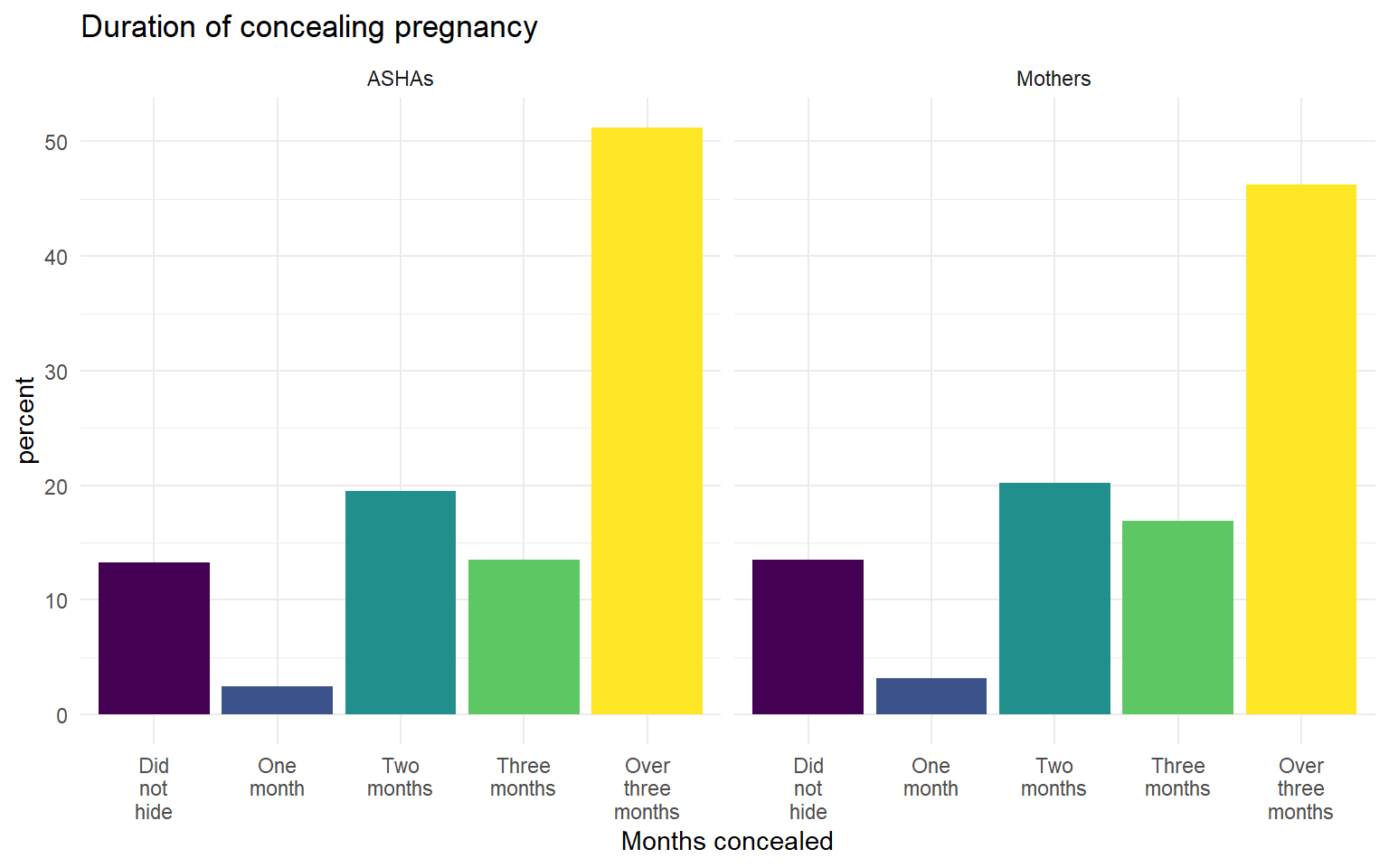
Figure 7.1: Location of most recent delivery: Mother sample
Applying substance to the cordstump
Likewise, the question Cordstump_Apply is shorthand for a question about the application of any substances to the umbilical cord stump shortly after it is cut. This question has several possible answers, but the one examined in this section is simply ‘yes’ for applied something or ‘no’ for applied nothing. This figure indicates that most women responded that they applied nothing, but about 25% applied ‘Blue medicine’ and just under 20% applied mustard seed oil. Blue medicine is a tropical antiseptic called gentian violet.
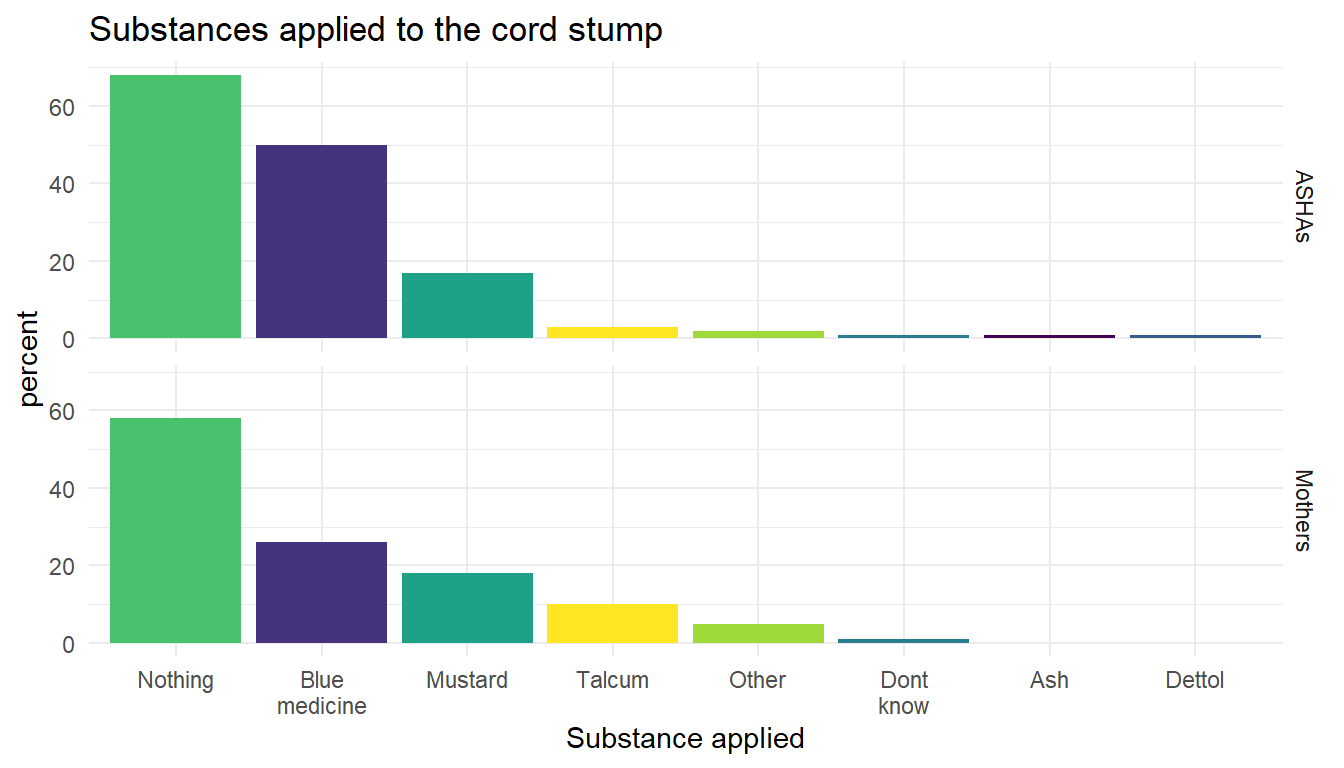
Figure 7.2: Frequency of responses for what may be applied to the cord stump
The response frequencies are again broadly similar, but with ASHAs much more likely to have used the blue medicine and Mothers more likely to have used Talcum.
Bathing the newborn
The biomedical recommendation is to not bath a newborn within 24 hours of birth (some states suggest even longer waiting periods). For the analysis, ‘yes’ is within 24 hours and any other response is ‘no.’
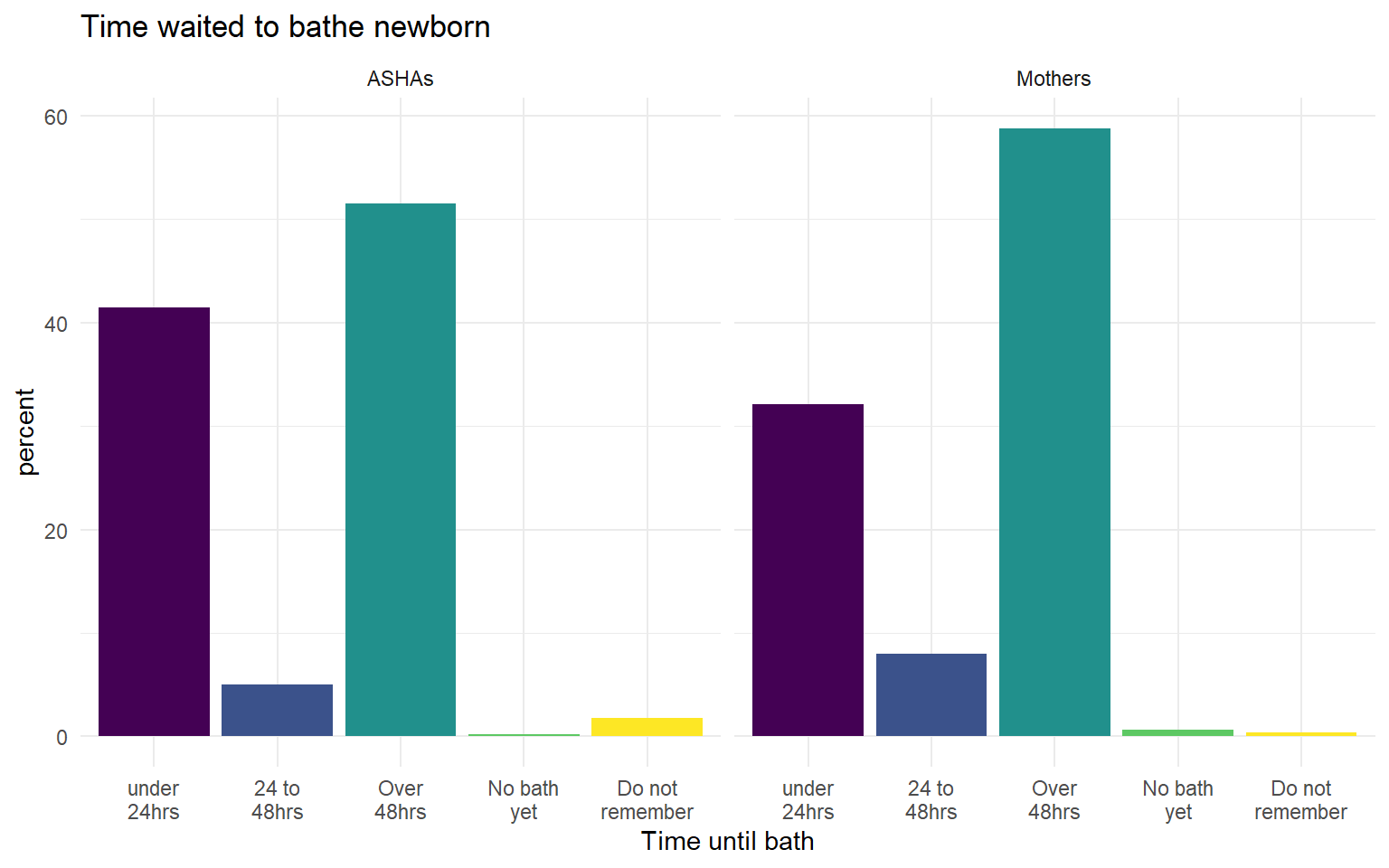
Figure 7.3: Bathing the newborn after delivery
More ASHAs bathed their newborns within 24 hours and more Mothers waited 48 hours or more. This behavior is very much within the household and we might expect it to be less under the influence of the ASHA than those more directly linked to accessing the medical system.
7.2.1.2 Biomedically recommended behaviors, recoded responses
ANC registration
The question in the survey asks in which month the mother registered for ANC in their most recent pregnancy. The recommendation is to do this as early as possible, but we coded as ‘yes’ ANC registrations occurring within the first three months of pregnancy. ASHAs were much more likely than Mothers to not have registered at all (response 98) and more Mothers registered within first 3 months. While this is still a behavior of concern, in terms of ideal health behaviors, there has been a great deal of improvement in the last decade or so.
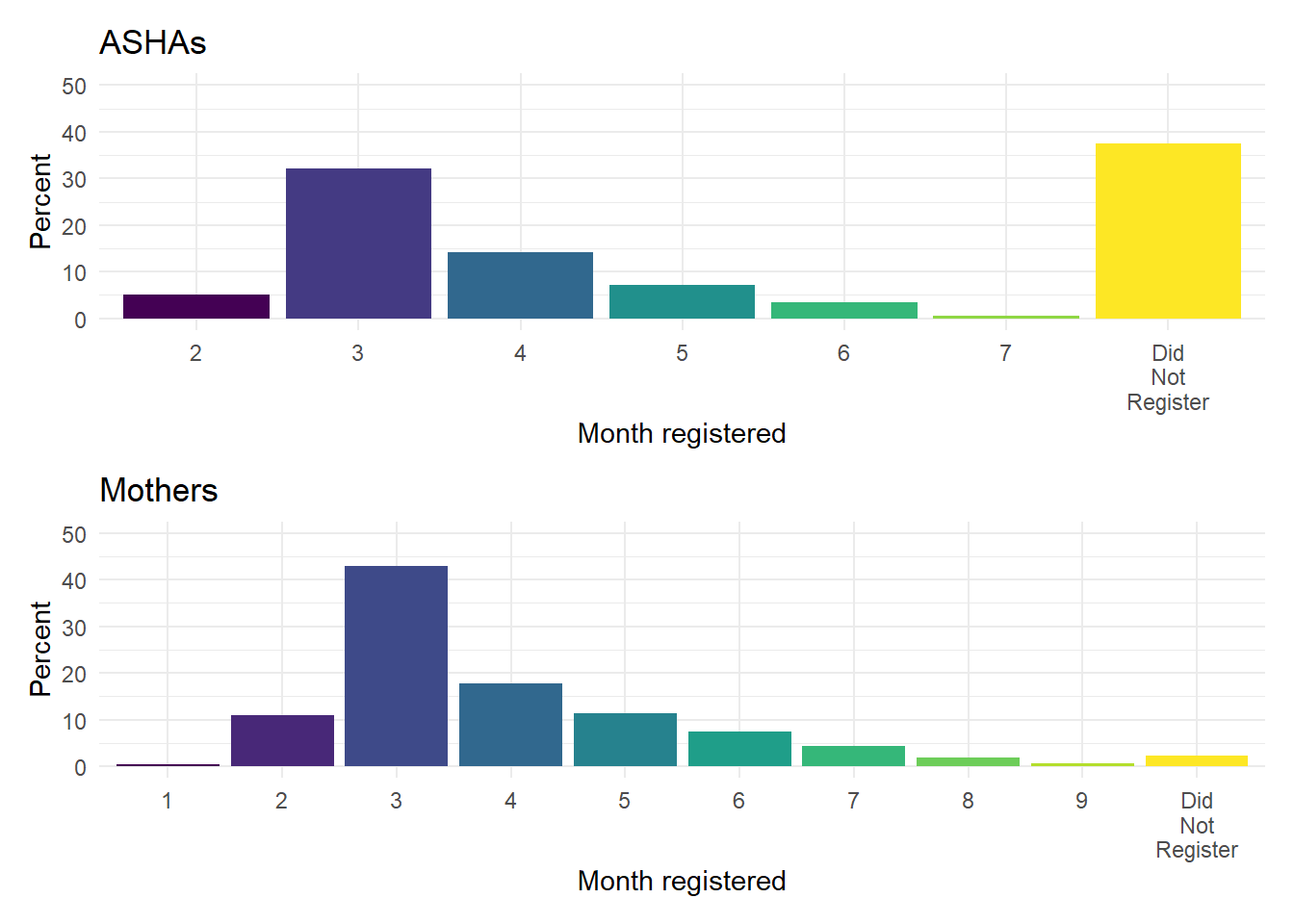
Figure 7.4: Self-reported antenatal-care registration by month of pregnancy
One consequence of coding this behavior into a binary, yes/no, response is that Mothers who registered just a little late, like in month 4, are given the same response as a mother who registered in month 9 or not at all. It will be important to keep this mind in later sections when we consider the reasons stated for registering or not registering. Those registering in months 4 or 5, especially, may be positively citing the ASHA as an influencer or giving reasons of the importance of ANC. Because these women registered they could be thinking that they were compliant with the recommended behavior. In this case, we emphasize timely/early registration.
To illustrate this further, please see Figure 7.5, which plots the month registered for four types of respondent: those who named the ANM as an influencer, those who did not name the ANM, those who named the ASHA as an influencer, and those who did not name the ASHA. For those registering from month 4 onward, it is much more likely to have NOT named an ASHA or an ANM as an influencer, but there are still a few respondents at later months who did name them.
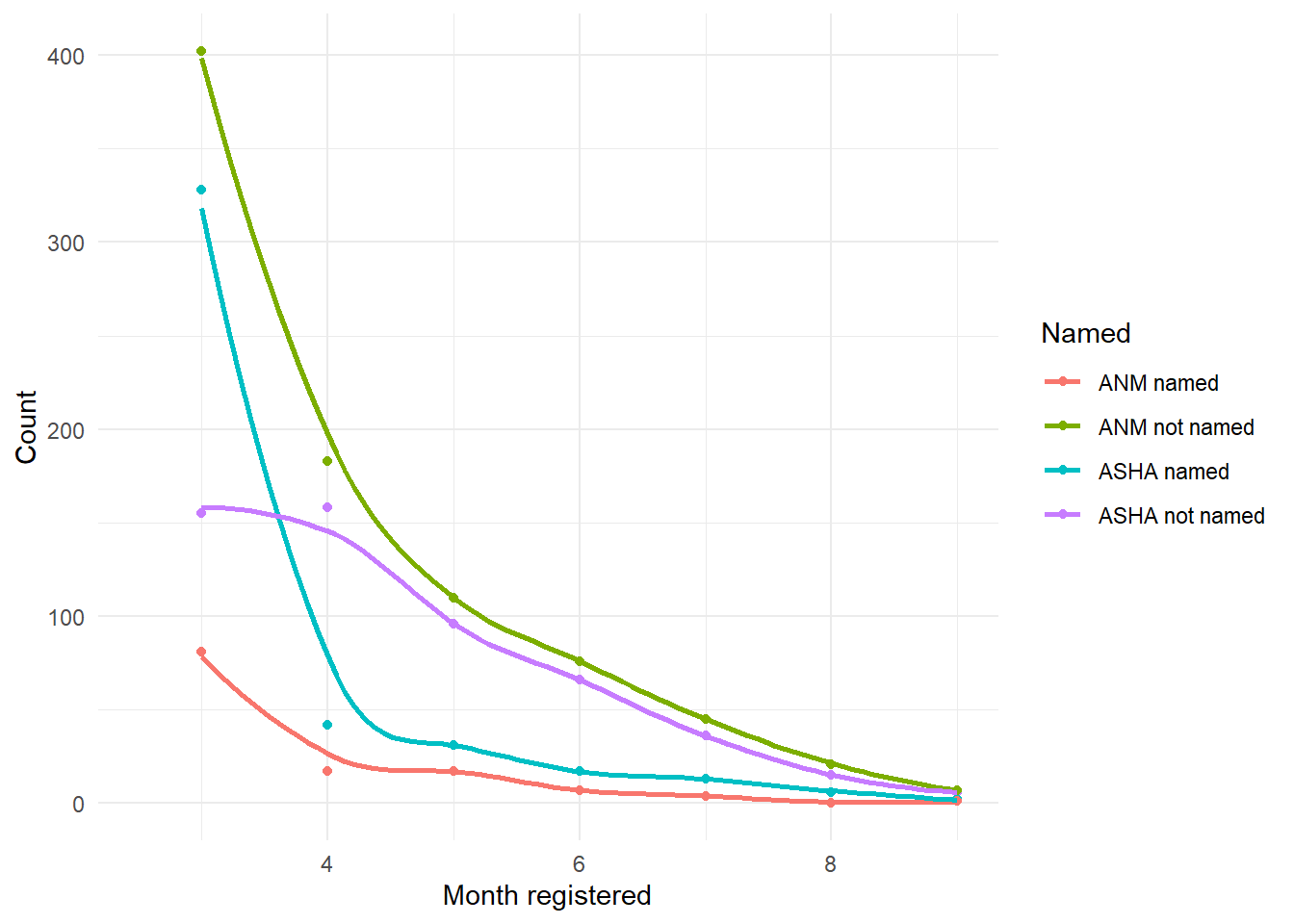
Figure 7.5: Count of number of Mother respondents who named or did not name the two main Community Health Workers in this study by month of ANC registration. Those registering after the third month were more likely to not mention an ANM or ASHA as an influence.
Institutional delivery
Institutional delivery has three options: government hospital, private hospital, or home. For the analysis we collapse the two kinds of hospitals into a ‘yes’ response for institutional delivery (Figure 7.6).
Here there is a fairly large shift away from home births and toward births in government hospitals from ASHAs to Mothers.
Most of the recent mothers, ~70%, had their most recent birth in a government hospital, compared to ~25% of ASHAs.
This increase could in part be due to the ASHA program itself causing a generational increase in the update of health behavior.
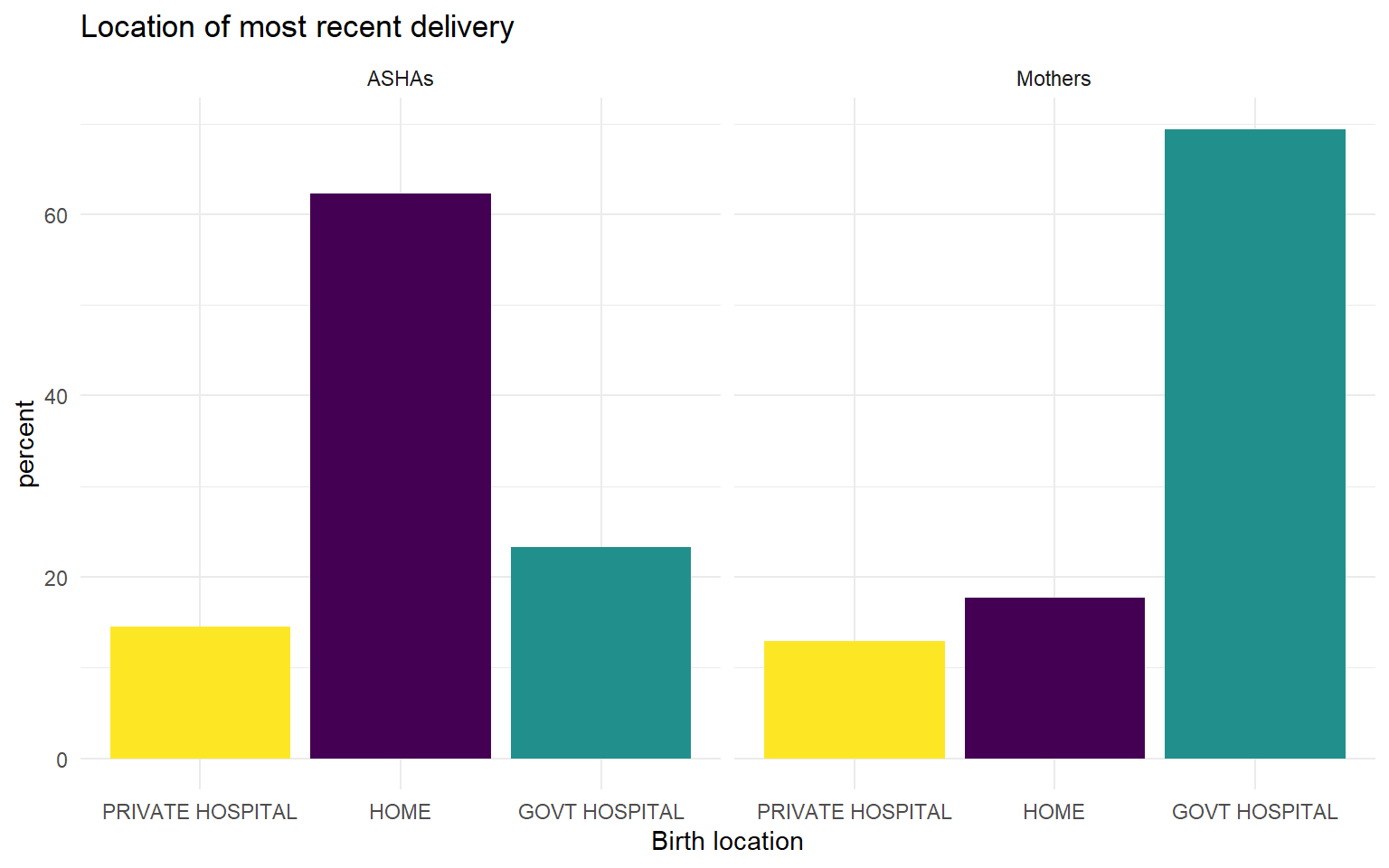
Figure 7.6: Location of most recent delivery: Mother sample
IFA tablets
Iron and folic acid tablets are an important dietary supplement, especially in areas where dietary nutrition may be limited. The recommendation is to take the full regimen of 100 tablets.
Fewer mothers than ASHAs have not taken any of the IFA tablet/syrup regimen but more ASHAs report having taken the full dosage. However, roughly over 20% of women are still not taking any IFA.
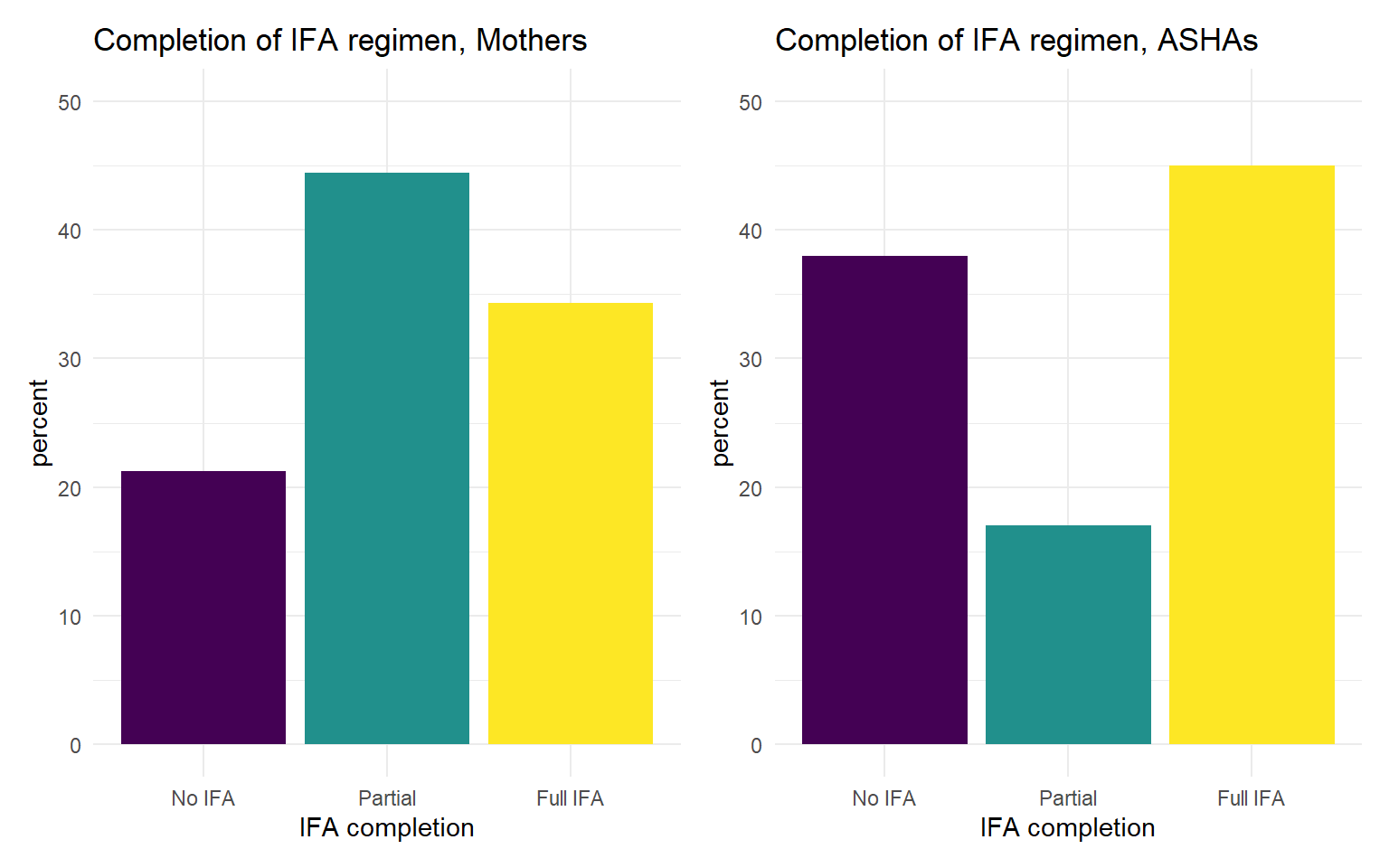
Diet
We have many questions related to diet. Here we compare the responses for two in particular that boil down to yes/no answers with nutritional implications. One asks about overall dietary intake during pregnancy. The response options are: increased the diet, made no change, decreased the diet. The second asks about fasting during pregnancy with response options of: did not fast, fasted for festivals, fasted regularly. From a strictly health perspective, the recommended responses are increase diet and do not fast.
But we were also interested to see if the responses were similar - for example, did the women who said they decreased their diets also say they fasted regularly (Table 7.3)? We see just about every combination of the responses to the two questions, which implies they are largely independent of each other (i.e., if these questions measure the same thing, then women who reduced their diets would mostly respond in the affirmative to having done some kind of fasting and those who increased their diets would not have fasted). Indeed, that these capture different concepts is not surprising. Fasting can mean a lot of different things, from fully forgoing food for a specified time or simply avoiding a few food groups.
Fewer mothers than ASHAs reported that they increased their diets during pregnancy, but fewer ASHAs responded with the recommended response of ‘did not fast’ during pregnancy.
| fast_festivals | fast_regular | no_fast | Total | |
|---|---|---|---|---|
| REDUCED | 36.5 | 0.8 | 8.0 | 45.3 |
| INCREASED | 17.8 | 0.8 | 7.5 | 26.1 |
| NO CHANGE | 23.0 | 0.8 | 5.0 | 28.8 |
| Total | 77.3 | 2.4 | 20.5 | 100.2 |
| fast_festivals | fast_regular | no_fast | Total | |
|---|---|---|---|---|
| DECREASED | 31.5 | 2.2 | 20.9 | 54.6 |
| INCREASED | 7.6 | 0.4 | 7.0 | 15.0 |
| NO CHANGE | 15.2 | 1.5 | 13.7 | 30.4 |
| Total | 54.3 | 4.1 | 41.6 | 100.0 |
For the overall dietary change during pregnancy and postpartum in the Mothers dataset, the most common response was to decrease the diet during pregnancy to and to make no change in the first week postpartum, while a lot of Mothers also made no change at either time. Moreover, about 8% of respondents decreased their diets in both pregnancy and postpartum. Of these women most did not take the full ifa regimen and some also avoided foods cereal in the first week after delivery, thus compounding a series of nutrition-limiting decisions.
| DECREASED | INCREASED | NO CHANGE | Total | |
|---|---|---|---|---|
| DECREASED | 7.9 | 34.6 | 12.1 | 54.6 |
| INCREASED | 2.7 | 7.2 | 5.1 | 15.0 |
| NO CHANGE | 4.6 | 8.4 | 17.3 | 30.3 |
| Total | 15.2 | 50.2 | 34.5 | 99.9 |
Take-home message
Based just on percentages of women self-reporting the behaviors they engaged in during their last pregnancy, we found that:
ASHAs and Mothers were most similar in these not recommended behaviors: concealing the pregnancy (over 85% in both groups!), working while pregnant (about 1/3 of each), and isolating the newborn after delivery (over 80% in both)
in these recommended behaviors: timely initiation of breast feeding (TIBF)(over 60% in both), feeding colostrum (near 80 % in both groups)
and in these neutral behaviors: avoiding markets while pregnant (over 60% in each), practicing Chhathi (near 75% in each), and having a Dai visit during pregnancy(around 1/3 of each)
the significance of these similarities varies based on the nature of the behavior, but we highlight that the similarity in Chhathi and avoiding markets shows the ways that there is a common ritual experience between the groups and that the high percentage concealing the pregancy shows how strong and persistent some of these concerns are, which partially relate to evil eye.
a greater percentage of ASHAs than Mothers reported these not recommended behaviors:
Fasting while pregnant (80% of ASHAs and 59% of Mothers), apply substance to the cordstump (68% and 58%), bathe a newborn within 24 hours of birth (42% and 32%)
and these recommended behaviors:
Taking the full regimen of IFA tablets (45% and 34%), Increasing the diet during pregnancy (26% and 15%!!), increasing the diet postpartum (66% and 50%)
and these neutral behaviors: calling the Dai at start of labor (65% and 55%), avoiding cereal after delivery (37% and 30%)
a greater percentage of Mothers than ASHAs reported these not recommended behaviors: (none)
and these recommended behaviors:
Early ANC Registration (29% of ASHAs and 52% of Mothers), Institutional delivery (38% and 83%)
and these neutral behaviors:
Abstaining from sexual intercourse during pregnancy (9% of ASHAs, 23% of Mothers), consulting a priest during pregnancy (7% and 15%)
Overall: There are significant improvements in Pregnancy Registration, Access to Antenatal Care, and Institutional Delivery, and it is not a coincidence that all these services have been the focus of public health initiatives and of the ASHA program in particular. Such behaviors are also relatively less rooted in traditional beliefs and norms. While these behaviors show a positive intergenerational change between ASHAs and Mothers, many of the home-based behaviors have mostly not changed in the percent who report doing them.